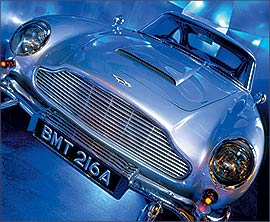


 |
 |
Issue Contents : : Feature Stories : : Curator of the Curious : : Page [ 1 2 3 ]
Out of the Black, and into the Gray
 |
|
| A replica of James Bond's silver-painted Aston Martin from the movie Goldfinger is a museum highlight.. | |
He pats Nipper's head and smiles. "Well, I think I've learned that nothing is black and white. The more you learn about history, the more you realize that it's mostly a matter of grays. Take the Cold War for example. How you tell that story depends on your point of view, doesn't it? Obviously, motivations and strategies differed, depending on which side you happened to be on.
"Or how about the Vietnam War? What was the war, when all is said and done? Were we really liberating a country, or were we trying to replace a colonial empire [the French] with our own form of colonialism? In hindsight, it becomes very difficult to be certain about what was going on. And I think we wind up talking about grays, rather than black and white."
Another important lesson, he says, has been his growing recognition of the fact that when it comes to understanding history--the authentic look and feel of things in the moment--capturing and presenting a few spare details is often more effective than writing a long dissertation.
Ask him to recall his own years at Oberlin, for example, and he'll talk at length about the excitement of studying history in classes where he was stretched to the limit. But push him to recall a specific moment that captures the "texture" of that Oberlin era (1967-72, in his case), and he'll surprise you. "I think one of my strongest memories of college is actually the smell of tear gas.
"We went to Washington in 1970 for one of the big anti-Vietnam War protests on the Mall, and somewhere up around Lafayette Park, we got tear-gassed by the cops. That's a smell--and a moment--that you don't forget!"
So can we truly know history? Are we capable of understanding the forces that shape it?
 |
|
| Among the tools of the spy trade on display at the museum are a one-bullet lipstick gun, a buttonhole camera, and a shoe radio | |
But Barrie doesn't seem to mind this state of affairs. He's enjoying his current role enormously, he says, as the éminence grise of some of America's most exciting museums.
"As you grow a bit older, you start to understand that human events are full of complexity, amazing complexity. And you realize that there's no shortage of ambiguity, either. It's all so tangled and huge. Sometimes life seems like a great labyrinth, with meanings and interpretations up for grabs at every step of the way.
"But that suits me just fine, because it allows for creativity," he adds. "I wake up each morning, and I can't wait to get into the office. Why? Because of the questions I know will be greeting me as soon as I walk in that door!"